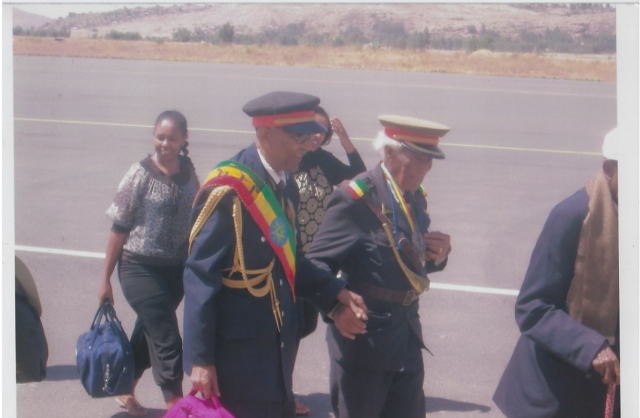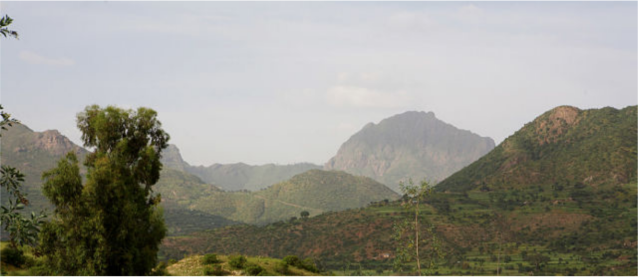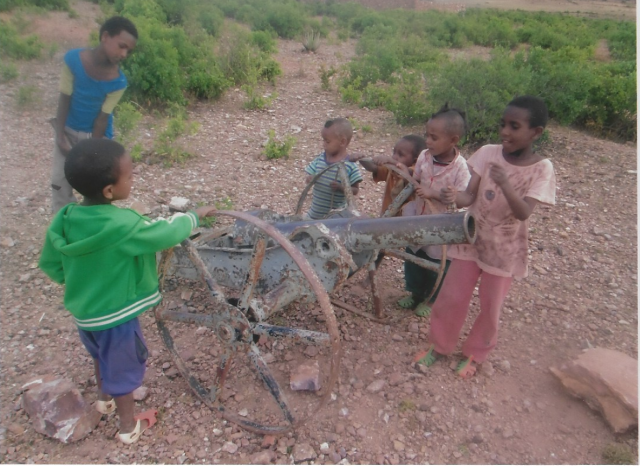 February is Black History Month and below is Professor Ayele Bekerie's reflection on the 125th anniversary of Ethiopia's victory at the Battle of Adwa, which is considered "a turning point in modern African history." (Photo: War Veterans heading to Adwa hand-in-hand to celebrate the victory at the Battle of Adwa in March 1896. By Ayele Bekerie)
February is Black History Month and below is Professor Ayele Bekerie's reflection on the 125th anniversary of Ethiopia's victory at the Battle of Adwa, which is considered "a turning point in modern African history." (Photo: War Veterans heading to Adwa hand-in-hand to celebrate the victory at the Battle of Adwa in March 1896. By Ayele Bekerie)
Tadias Magazine
By Ayele Bekerie, PhD
February 1st, 2021
Unrealized Victory of the Battle of Adwa: Unity Then for Freedom and Unity Now for Transformation
Mekelle University, Ethiopia (TADIAS) — The Ethiopians, 125 years ago, reversed the course of colonial history. At the Battle of Adwa, on March 1, 1896, they successfully unsettled the colonizers and paved the way for anti-colonial resistance in Africa. They charted a new strategy to ultimately defeat colonialism in Africa and elsewhere. The united and highly disciplined Ethiopian force achieved irreversible victory at the battlefield and obliged the Italians to retreat and return back to their native land. To be concise, at Adwa, Africa defeated Europe. Simply put, Adwa became a turning point in modern African history.
The Italians call the Battle of Adwa, the Battle of Aba Gerima, a mountain top location that was used as a command center for the Ethiopian military leadership. It was next to Aba Gerima, at the foot of Mount Kidane Mehret, the first and by far the most decisive battle took place. Later, the battle site was named mindibdib, which means total annihilation. The Italians’ ambition for colonial expansion came to a halt at the foot of the majestic mountains of Abba Gerima, as well as Mount Kidane Mehret and Mount Gesseso. These mountains, including Mount Belah, Mount Raeyo, Mount Enda Kidane Mehret, Mount Solado and Mount Zubin Daero, form not only spectacular landscape of Adwa and its surroundings, but they also remain as mountains of natural fortress for Ethiopian fighters. They are remarkable landmarks of Adwa. Ethiopians fought the Italians at sites of their choosing.

The mountains of Adwa, Permanent Landmarks of Victory. (Photo by Chester Higgins of the New York
Times)
Imminent historians and other scholars have written extensively about the Battle. One of the most comprehensive and scientific historical narratives on the Battle of Adwa is Raymond Jonas’s The Battle of Adwa: African Victory in the Age of Empire in 2011. Jonas’s widely praised book for its fair treatment of all the key players and deeds of the Battle, is a second book on the subject. The first book on the Battle was written by a British Journalist August Wilde, who witnessed the Battle and wrote the first book entitled Modern Abyssinia in 1903. Contrary to Jonas, Wylde wrote the book ‘to prevent another white failure in Ethiopia.’
The major newspapers and magazines of the world placed the victory in their cover pages. Afro-Brazilian newspaper, which is recently revived, named itself ‘O Menelick.’ Parents were quick to name their offspring, from Hungary to France, Menelik, Taitu, Balcha, and Allula. The European Press reported the victory favorably. Vanity Fair, for instance, published in its cover page, a colored lithograph of Emperor Menelik II. Le Petit Journal also had the victory in its front page. Even the victory at Amba Alage triggered Italian students from Rome University to march on the streets of Rome shouting ‘Viva Menelik!’
Pan-Africanist Benito Sylvain travelled to Addis Ababa from Paris to congratulate Emperor Menelik on his victory. He later served as a delegate to the first Pan-African Congress in 1900 in London representing Ethiopia and Haiti. The Haitian Dr. Sylvain had a chance to celebrate the centennial anniversary of the Haitian Revolution of 1804 in Addis Ababa.
The National Archive and Library Agency (NALA) has a large collection of manuscripts and documents in Amharic on the Battle of Adwa. Among the Ethiopian scholars who documented and written about the Battle are: Belata Mersea Hazen Wolde Qirqos, Dejazmach Doctor Zewde Gebre Selassie, Dejazemach Kebede Tesema, Aleqa Taye Gebre Mariam, Fitawrari Tekle Hawariat Tekle Mariam and Dejazemach Zewde Reta as well as Paulos Gnogno. A useful source of the Battle also includes Tsehafe Tezaz Gebre Selassie’s Tarike Zemen Ze Dagmawi Menelik Nehuse Negest Ze Ethiopia (Historical Period of Emperor Menelik II of Ethiopia) published in Amharic in 1967.
Abuna Gerima’s summit was the command center in which the commander of the Ethiopian force (foot soldiers and cavalry), Ras Mekonnen Wolde Mikael monitored troop movements of the enemy. He had the height advantage to survey and give orders to his lieutenants. The Italians gathered at their fortress at Sawrya not far from the final battle fields and headed to Adwa. They marched at night with the intent of surprise attack at the break of day. The fateful night was rainy and the Italians got lost in the many mountains of Adwa. By the time, they made their way to the first battlefield, the Ethiopians were ready to encircle and defeat them within hours. The Ethiopians were aided by spies who provided the latest information regarding the movement of the Italians.
Ras Mekonnen’s memorial statue in Harar, eastern Ethiopia, was sadly destroyed by a mob following the assassination of Artist Hachalu Hundesa in 2019. Ras Mekonnen served his country both as diplomat and military commander. He was by far the most trusted advisor to the Emperor. His army from eastern Ethiopia fought battles at Amba Alage, Mekelle and Adwa. In all the three cases, they were victorious, given that they made priceless sacrifices to achieve their goal. Fighters from Harar sustained heavy losses in an attempt to dislodge the Italians from their fortress at Endayesus in Mekelle. The freedom we enjoy and the country we love was made possible because of the sacrifices of our gallant fighting traditions of our ancestors. Erecting and keeping monuments to our heroes are the least we can do to ascertain our Ethiopian identity and nationhood ascertained by historical deeds.
Abuna Gerima is the site of one of the oldest Ethiopian Orthodox Tewahedo Church monasteries. It houses a rare collection of religious manuscripts. It is now famous worldwide, for it is home to the earliest illuminated parchment bible in the world. The Bible (Old and New Testaments) is carbon-dated in a laboratory at Oxford University to circa 6th century of the Common Era. The manuscript was written in Ge’ez, which literally means free, is the ancient and classical language of Ethiopia. Abune Gerima. given its multiple historic relevance, ought to be preferred destination for visit and spiritual fulfillment. Besides, the great general Ras Alula Aba Nega, who started resisting the Italian colonizers long before the Battle of Adwa during the reign of Emperor Yohannes IV and continued at Adwa, buried at the monastery. His cemetery is built few years ago and is standing intact.
The Italian colonization strategy was based on exploitation of ethnic and religious differences in Ethiopia. They tried to play one regional king against another. They also attempted to draw Muslim Ethiopians to their side. Often the colonizers strategy rests upon the introduction of Christianity to the so-called natives. That was a trick that cannot be duplicated in Ethiopia. Ethiopians embraced Christianity almost since the beginning of the faith. Christianity was perhaps introduced here earlier than Rome. Simply, Christianity has deeper roots in Ethiopia and therefore cannot be used as a tool of colonization. Furthermore, divide and rule strategy was decisively countered when Ethiopians were able to set aside their differences and fought the enemy as one. Besides, Menelik and Taitu as leaders and partners were harmonious and understanding with each other. They both vigorously campaigned for the unification of the empire. They were also endowed with strategic acumen.
Their exemplary joint campaign did not stop at Adwa. In post-Adwa Ethiopia, the co-leaders were engaged in establishing, for the first time, the instruments of modern state. The co-leaders introduced electricity, automobile, telephone, photography, and railway. In addition, bank, hospitals, hotel service, piped water and police force.
In the last three decades, systematic campaign was carried out by the enemy from within in an attempt to diminish the significance of the victory at the Battle of Adwa. Some said the Battle was not necessary, others lament that the victory did not result in unity, and the rest from the enemy camp resorted to raw insults of the heroic leaders. It is one thing to conduct constructive criticism of the execution of the Battle and historical journeys of the post-Adwa Ethiopia. That was not the case. Recent events in the north clearly showed that the enemy from within was aiming to dismember the country. Scramble for Africa may have begun in 1884 and left behind a colonial legacy that will take years to fully undress and undo. What we have witnessed in the last few years was an attempt to restore the scramble for Africa with the intent of settling accounts in Ethiopia, the only country that has never been colonized. Enemies from within and without collude to write what they thought would be the final chapter of the scramble for Africa. This time it is planned but failed to be executed in Ethiopia by covertly engaging in destabilizing the state. It is clear from the remarkable unity displayed by Ethiopians in supporting the Ethiopian National Defense Forces when attacked in the north. The Ethiopians are saying no to scramble for Ethiopia.
Apart from wanton destruction of Ras Mekonnen Wolde Mikael’s statue in Harar, these past years, we have witnessed additional physical assaults on memorials of our heroines. The cemetery-monument of Ras Abate BwaYalew, the young and skillful gunner, at Debre Libanos Monastery, was dismantled in the name of development. The monument was built by his family members. Since they have saved the monument in picture forms, heritage guardians should mobilize forces to rebuild the Ras Abate’s memorial at the chosen site.
Two years ago, Ethiopians in the diaspora and at home, sought to lay a foundation stone to build a memorial park for Empress Taitu in Adwa Bridge Park in Addis Ababa. Announcement was made and guests were invited to undertake the event. Alemtsehay Wodajo, who runs Taitu Cultural Center, an institution named after Empress Taitu in Washington D.C., was a co-host of the event together with the Addis Ababa City administration. Unfortunately, the event was unexpectedly cancelled without any explanation. Empress Taitu made significant contribution to the building of modern Ethiopia. She led her own specialized forces at the Battle. She also organized 10,000 women logisticians to provide water for the army at the battlefields. She certainly deserves a statue in Addis Ababa she found.
While we are at it, it is important to remember that the first hotel in Addis Ababa, Taitu Hotel was damaged by fire. To this date, it is not fully restored. Tadias did a story on the damaged caused to the historic building at the time of the incident.
Another disappointment regarding Adwa is the unfulfilled dream to establish Adwa Pan-African University (APAU). The foundation stone is laid in the presence of the former Prime Minister Haile Mariam Desalegn and some African leaders, including President Yoweri Museveni of Uganda in April 2018. Land is endowed. Concept paper is written. Local and international conferences conducted on the subject. Architectural design is completed. And yet APAU still remains a dream deferred.
While the implementation of APAU in Adwa is on hold, the Addis Ababa City Administration is constructing a massive cultural and commercial center at ground zero, the center-most of Addis Ababa, not far from the statue of Emperor Menelik II and St George Church in Arada sub-city. The complex structure displays the letter A for Adwa on its roof. The Center once completed will have a museum, shopping centers, cafes and entertainment units.
Contrary to the popular and misleading notion, the Ethiopians were well-armed and prepared to confront the invading Italian army. For instance, the Ethiopians acquired artillery that was by far superior to the Italians. While the Ethiopian artillery hit range was 4,500 meters, the Italians counterpart was limited to 3,800 hit range. The Ethiopian army had 70,000 modern rifles and 5 million rounds of ammunition. The Battle was not fought with spears and shields alone. The cavalry unit may have used spears and shields extensively. And yet, historians have recorded the agility and the speed with which the horses manage the hills up or down during battle engagements. In short, as one observer puts it, “Emperor Menelik II built an army that is reasonably comparable to the European colonizers in weaponry and personnel.”

Children playing with an abandoned artillery left at Mindibdib, the site of the first decisive battle. Ethiopians routed the Italian battalion within hours of the engagement. (Photo by Ayele Bekerie)
One-hundred-and-a-quarter century passed since the Ethiopian army defeated the Italian colonial invaders at the Battle of Adwa. As if to compensate for the gallant but unsuccessful resistance against the colonial encroachment of the 18 th and 19 centuries in Africa, the Ethiopians decisively affirmed with their victory the beginning of the end of colonialism. The Italians were assigned the Horn of Africa at the 1884/85 Berlin Conference where 14 European countries were in attendance. Once Austrian-occupied Italy expected a quick victory for their almost 20,000 strong invasion forces.
As one observer puts it, given Italy’s fractured nature of nation-state building and imperial ambition, they were not capable of challenging the Menelik’s war-tested and united force and diplomatically sophisticated Ethiopian state. Emperor Menelik engaged Europe diplomatically to acquire modern weapons. He successfully played one European colonial power against another in order to keep Ethiopia free of their colonial encroachments. Local or European diplomats like Alfred Ilg conducted effective public relation campaign in Europe.
The Ethiopians also excelled the Italians in intelligence gatherings and effective use. The Ethiopians had the latest information, thanks to the works of Basha Awalom and Ato Gebre Hiwot, who chose to serve and remain loyal to the national agenda of. As a result, their intelligence gathering and sharing information regarding the movement of the Italian battalions with the Ethiopian military leadership at Adwa, made a critical difference in tilting the victory to the home front.
Instead of enhancing historical achievements thereby addressing peaceable co-existence, we expend a great deal of resources to narrow and stultify our sense of who we are. Ethnic identity seems to have absolute priority over our Ethiopian identity. Our approach to ethnicity is so dangerous that we are willing to carry out the most heinous violent crimes against those who are conveniently labeled outsiders.
In the last thirty years, identity gravitated to extreme and divisive positions. Identity is defined by negative legitimacy. That means, one defines his or her identity by mere sense of victimhood and by blaming and hating others.
I argue that the full meaning and relevance of the victory at Adwa has yet to be realized within Ethiopia, as Maimre Mennsemay also noted. It was the power of multiple and united voices that enabled Ethiopians to be victorious. That formula of unity should be repeated now to counter the large-scale displacements and violence encountered by our fellow Ethiopians throughout the country to this date.
Killel is a killer. Killel discriminates. Killel hast turned into fatal division of us versus them. Killel is a thriving ground for political opportunists and ethno-racists. Killel appears to be a sure way to let ethno-nationalists, driven by selfishness, continuously make attempts to dismember the country. Killel or what has evolved to be self-governing mechanism is in actuality an instrument to displace and kill those who are labeled outsiders. The maxim of Adwa is to respect geographical and cultural diversity and to strive in unison as one country and people to build a better and stronger nation. Most historians also agree that Adwa paved the way for the ultimate demise of colonialism in Africa and elsewhere.
—
About the author:
Ayele Bekerie is an Associate Professor and Coordinator of PhD Program in Heritage Studies and Coordinator of International Affairs at Mekelle University’s Institute of Paleo-Environment and Heritage Conservation. Previously, he was an Assistant Professor at the Africana Studies and Research Center at Cornell University in the United States. Ayele Bekerie is a contributing author in the acclaimed book, “One House: The Battle of Adwa 1896 -100 Years.” He is also the author of the award-winning book “Ethiopic, An African Writing System: Its History and Principles” — among many other published works.
Related:
The Making of Global Adwa: By Professor Ayele Bekerie
The Concept Behind the Adwa Pan-African University: Interview with Dr. Ayele Bekerie
Ethiopia: The Victory of Adwa, An Exemplary Triumph to the Rest of Africa
Adwa: Genesis of Unscrambled Africa
119 Years Anniversary of Ethiopia’s Victory at the Battle of Adwa on March 1st, 1896
Reflection on 118th Anniversary of Ethiopia’s Victory at Adwa
The Significance of the 1896 Battle of Adwa
Call for the Registry of Adwa as UNESCO World Heritage Site
Join the conversation on Twitter and Facebook.

























